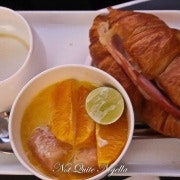A glutton in Guangzhou
Australia's favourite food blogger Not Quite Nigella, aka Lorraine Elliott, samples some unusual seafood in the bustling Chinese metropolis.
It’s a city of numbers and statistics in the millions. There are 10 million inhabitants of Guangzhou alone, with 1 million extra foreign residents doing business with the industrial city. Its Pearl River is the third largest river in China and our guide Hobbie reminisces of a time when the now muddy brown river was clear enough for him to swim in. It was only in the 1980s that “you could see the fish in the water”, he says. You could also see the pearl-coloured stones at the bottom, which gave the river its name. Industrialism has given the city vigour, but also clouds it in a thick fog of pollution and tinges the river a light brown.
The people of Guangzhou are busy. They’re busy riding bikes in many forms. I see someone gliding by on an electric bike, while moments later a woman struggles up one of the expressway overpasses sharing the right-most lane right next to a car. Motorcycles are banned in the city area because of the amount of fatalities. But in China the uptake of cars, particularly luxury cars, is fast and I see an Audi and a Mercedes pass the woman struggling on her bike.

Crossing the city on a bus, we drive through the old town where the lanes narrow and mango trees line the pavement, and bamboo scaffolding and laundry encase old buildings. The government owns the mango trees and in a month or so workers will gather the ripe fruit and sell it at the market.
It’s hot and sticky with 80 per cent humidity (at 5:30 in the morning when we arrived it was already 28 degrees celcius). The streets turn into manicured, green-lined ones, flanked by fabric shops and electronics stores. Vendors sell bundles of fresh mangosteens, rambutans and lychees on the vine.
Our first stop is lunch at Hong Xing restaurant in Guangzhou. The thing about asking guides to show you where the locals really eat is that they take you with the very best intentions to somewhere that they think that you want to go, which is usually a place with a lot of foreigners and Western-style food. It’s only after much discussion with David, who is leading the group, that he takes us to Hong Xing.
It’s unlike any restaurant you’re likely to encounter in Australia. The first sight that greets you is jars filled with herbal concoctions, including whole snakes. Then there is the enormous display of live seafood, far beyond the ordinary fish, crab and lobster you might find at home. They’re all sitting market-style (or aquarium-style, as one diner calls it) under running water, the lobsters flicking a leg here and there or a crab’s eye rising up and down.

The variety is astounding and we walk up and down the display ogling seafood from China, Canada, Thailand and Australia. Apart from crab, prawns, lobster and fish there are unusual items like Haibao snake, crocodile snout, Beijing River eel, whelks, sturgeon, live Alaskan crab (we tend to only get frozen) and enormous oysters the size of my palm. The sheer variety makes it hard to choose.
We take our pick of seafood – all items that we simply can’t get back in Australia, ranging from large mussels which rise up like fingers curled over. We bypass the supposedly aphrodisiac Geoduck clams, which look like male appendages or elephant trunks. I don’t think the menfolk could handle the idea of eating them…
What we thought would be finger-like mussels cook down to tender, slippery mussels without any sort of chewiness. They’re cooked with black bean, chilli and a hint of mandarin skin. They’re a favourite at the table.
The sea prawn dish was also a revelation for us. The prawns are baked in a hot pot and then they’re served with deep-fried, crispy tea leaves. You eat them whole, head and all, and the tea leaves have a surprisingly mild flavour without any tannins. The sauce is a soy-based one with dark and light soy. It’s the sort of dish that has us quizzing our guide as to preparation methods.
The wild sea crab was recommended to us and it was a small, dark and khaki-coloured. It was beautifully tender and cooked perfectly, although the sauce was an interesting one and not like the black pepper sauces that we have had. That’s not to say that it wasn’t good but it wasn’t what we were expecting.
To read the full post, click here.
















